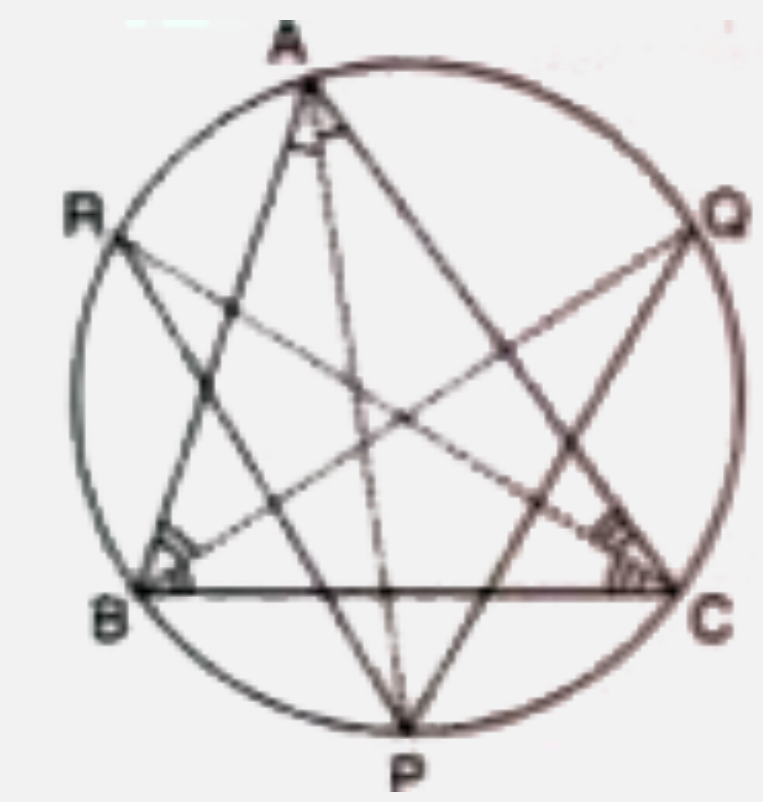In ΔABC, P is an interior point such that ∠PAB=10∘,∠PBA=20∘,∠PCA=30∘,∠PAC=40∘ then ΔABC is
isosceles
right angled
equilateral
obtuse angled
The correct Answer is:A
To solve the problem, we need to analyze the angles given in triangle ABC with point P inside it. Here’s a step-by-step breakdown of the solution:
Step 1: Understand the Angles
We are given:
- ∠PAB=10∘
- ∠PBA=20∘
- ∠PCA=30∘
- ∠PAC=40∘
We need to find the angles of triangle ABC.
Step 2: Determine Angle PBC
Let ∠PBC=x. We can now express the angles at point B:
- ∠ABC=∠PBA+∠PBC=20∘+x
Step 3: Calculate Angle ACB
Using the angles around point P, we can find ∠ACB:
- ∠ACB=∠PCA+∠PAC=30∘+40∘=70∘
Step 4: Use Angle Sum Property in Triangle ABC
The sum of the angles in triangle ABC must equal 180∘:
∠ABC+∠ACB+∠BAC=180∘
Substituting the known values:
(20∘+x)+70∘+∠BAC=180∘
This simplifies to:
90∘+x+∠BAC=180∘
Thus:
∠BAC=90∘−x
Step 5: Find the Value of x
Now we have:
- ∠ABC=20∘+x
- ∠ACB=70∘
- ∠BAC=90∘−x
Using the sine law as mentioned in the transcript, we set up the equation:
sin(20∘)⋅sin(80∘−x)⋅sin(40∘)=sin(30∘)⋅sin(10∘)⋅sin(x)
Step 6: Simplify and Solve
Using the sine double angle identity:
sin(20∘)=2sin(10∘)cos(10∘)
We can substitute this into our equation and simplify. After simplification, we find that x=60∘.
Step 7: Find Angles of Triangle ABC
Now substituting x=60∘:
- ∠ABC=20∘+60∘=80∘
- ∠BAC=90∘−60∘=30∘
- ∠ACB=70∘
Step 8: Identify Triangle Type
From the angles:
- ∠A=30∘
- ∠B=80∘
- ∠C=70∘
Since ∠A≠∠B≠∠C, triangle ABC is not equilateral or isosceles. The angles indicate that it is an acute triangle.
Conclusion
Thus, triangle ABC is an acute triangle.
We are given:
- ∠PAB=10∘
- ∠PBA=20∘
- ∠PCA=30∘
- ∠PAC=40∘
Let ∠PBC=x. We can now express the angles at point B:
- ∠ABC=∠PBA+∠PBC=20∘+x
Using the angles around point P, we can find ∠ACB:
- ∠ACB=∠PCA+∠PAC=30∘+40∘=70∘
The sum of the angles in triangle ABC must equal 180∘:
∠ABC+∠ACB+∠BAC=180∘
Substituting the known values:
(20∘+x)+70∘+∠BAC=180∘
This simplifies to:
90∘+x+∠BAC=180∘
Thus:
∠BAC=90∘−x
Now we have:
- ∠ABC=20∘+x
- ∠ACB=70∘
- ∠BAC=90∘−x
sin(20∘)⋅sin(80∘−x)⋅sin(40∘)=sin(30∘)⋅sin(10∘)⋅sin(x)
Using the sine double angle identity:
sin(20∘)=2sin(10∘)cos(10∘)
We can substitute this into our equation and simplify. After simplification, we find that x=60∘.
Now substituting x=60∘:
- ∠ABC=20∘+60∘=80∘
- ∠BAC=90∘−60∘=30∘
- ∠ACB=70∘
From the angles:
- ∠A=30∘
- ∠B=80∘
- ∠C=70∘
Thus, triangle ABC is an acute triangle.
Topper's Solved these Questions
- PROPERTIES AND SOLUTIONS OF TRIANGLEBOOK - CENGAGE ENGLISHCHAPTER - PROPERTIES AND SOLUTIONS OF TRIANGLEEXERCISE - Multiple correct answer type
24 Videos
- PROPERTIES AND SOLUTIONS OF TRIANGLEBOOK - CENGAGE ENGLISHCHAPTER - PROPERTIES AND SOLUTIONS OF TRIANGLEEXERCISE - Linked comprehension type
34 Videos
- PROPERTIES AND SOLUTIONS OF TRIANGLEBOOK - CENGAGE ENGLISHCHAPTER - PROPERTIES AND SOLUTIONS OF TRIANGLEEXERCISE - Concept application exercise 5.11
4 Videos
- PROGRESSION AND SERIESBOOK - CENGAGE ENGLISHCHAPTER - PROGRESSION AND SERIESEXERCISE - ARCHIVES (MATRIX MATCH TYPE )
1 Videos
- RELATIONS AND FUNCTIONSBOOK - CENGAGE ENGLISHCHAPTER - RELATIONS AND FUNCTIONSEXERCISE - Archives(Matrix Match Type)
1 Videos
Similar Questions
Knowledge Check
In a ΔABC,if∠A=40∘and∠B=55∘ then ∠C is
A75∘B80∘C95∘D85∘
In triangle ABC ,∠B=90∘,AB=40,AC+BC=80, Find :
cos A
View SolutionWhich of the following pairs of triangles are congruent ? In each case, state the condition of congruency :
(a) In ΔABCandΔDEF, AB = DE, BC = EF and ∠B=∠E.
(b) In ΔABCandΔDEF,∠B=∠E=90∘, AC = DF and BC = EF.
(c) In ΔABCandΔQRP, AB = QR, ∠B=∠Rand∠C=∠P.
(d) In ΔABCandΔPQR, AB = PQ, AC = PR and BC = QR.
(e) In ΔABCandΔPQR, BC = QR, ∠A=90∘,∠C=∠R=40∘and∠Q=50∘.
View SolutionP is any point inside the triangle ABC. Prove that : ∠BPC>∠BAC.
View SolutionIn triangle ABC ,∠B=90∘,AB=40,AC+BC=80, Find :
tan C .
View SolutionIn a ΔABC, if a = 40, c=40√3 and B=30∘, then the triangle is
View SolutionThe given figure shows a triangle ABC with ∠BAC=56∘and∠ABC=64∘, Bisectors of angles A,B and C meet the circumcircle of the ΔABC at points P,Q and R respectively . Find the measure of ∠QPR.

View SolutionFind λ if (λ,λ+1) is an interior point of ΔABC where,A≡(0,3),B≡(−2,0) and C≡(6,1).
View Solution
